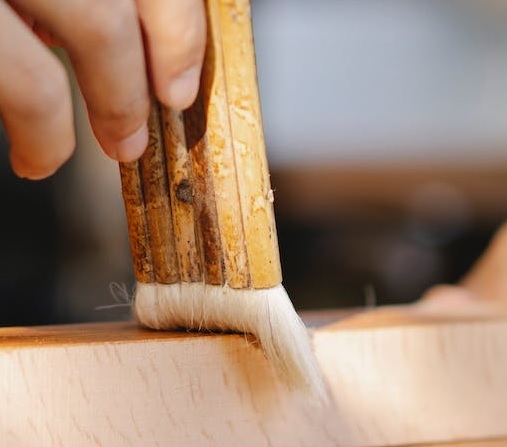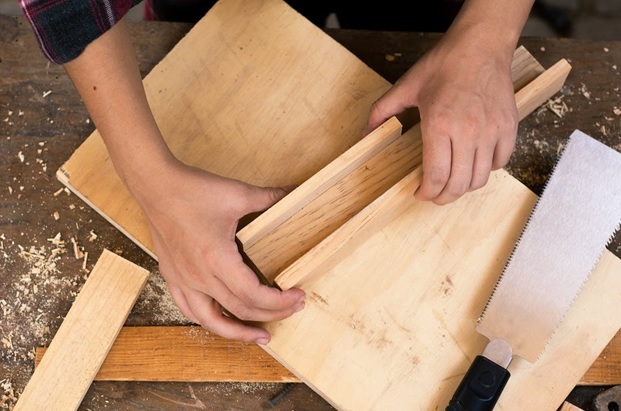Applying Walnut Veneer Sheets with Contact Cement? Use This Guide to Troubleshoot Issues
Jul 18th 2023
Walnut veneer sheets can be an economical way to complete your woodworking project with the dark, lustrous tones of American black walnut at a fraction of the cost of solid wood.
Applying walnut veneer sheets with contact cement is a common method - but make sure you don’t fall prey to these issues (covered below, along with what you can do about them).
First: Make Sure You Buy Enough Walnut Veneer Sheets
First things first, make sure you buy enough walnut veneer sheets to complete the project.
Regardless of the matching sequence you plan to follow, you want to have enough veneer on hand to complete the project from the start.
The reason for this is that matching veneer sheets cannot be procured after the fact, even if you buy the exact same species, and even the exact same cut.
The only way to guarantee seamless matching is to purchase an adequate quantity of veneer from the same stock the first time, and ask for sequence matching – an upcharge that is well worth the price!
Apply It Properly the First Time
The second aspect of making sure your project works out is to make sure you apply the veneer properly the first time around.
That is, follow these tips for using contact cement:
- Climatize the veneer and substrate by storing them together and under the same conditions for a period of at least 48 hours, especially if your walnut veneer sheets are coming from a different climate than your own.
- Do not attempt to apply wood veneer sheets if the relative humidity is above 51%.
- Allow the proper drying time (flash time) between coats of adhesive.
- A wood scraper must be used.. A “carpet tucker” (found at Lowes) works well for this. The proper level of pressure is necessary to activate the adhesive. Do not use a J-roller as you will not be able to apply enough pressure.
- Apply one thin coat of ahesive on non-porous board and two on plywood.
- You need 100% coverage on both veneer sheet and substrate.
- Apply veneer with contact cement only to suitable surfaces, such as medium-density fiberboard, particleboard, and plywood. Do not apply wood veneer to melamine (a material used to make laminate furniture).
Common Issues with Contact Cement

Not only does applying walnut veneer sheets with contact cement require certain skills and considerations, but there are a variety of common issues you should be prepared for.
The goal here is to avoid these, but if they do manifest, here’s what to look for and what you can do about it.
- Edge Lifting
Edge lifting occurs when the edges or corners of your walnut wood veneer sheets pull away from the edge of the substrate. Sometimes they curl up, other times there is just a tiny gap between the sheet and the substrate.
There are three main reasons this occurs. One is insufficient use of adhesive, one is combining too soon, which traps solvent, and another is not using enough pressure to press the veneer to the substrate.
The solutions are to apply more adhesive (once again 100% coverage), increase the drying time, and to apply more pressure when pressing out the veneer.
- Bubble Formation
Bubbles also form in the surface of wood veneer sheets, most commonly because of trapped solvents, irregular adhesion coverage or compression, or the use of an ineffective adhesive. Bubbles can also form when you bond the edges first instead of working outward from the center of the sheet.
You can check for bubbles by feeling the surface of the veneer or by shining a light across the surface of the veneer to look for raised areas or shadows.
There are a few fixes to bubbles in veneer. You can increase drying time, use adhesive with more solids, and double check your application and compression methods. You can also slit the bubble in the middle along the grain, warm the surface with an iron, and press it back down.
You should also always work from the center outwards to make sure the bubbles are pressed out.
- Adhesive Failure
Adhesive failure usually occurs because of the use of the wrong adhesive or substrate, or due to insufficient adhesion coverage. It can also occur due to a contaminated substrate surface or to the presence of excess atmospheric moisture.
There are a few ways to prevent this. One is to keep the work area clean and double check that the substrate and backer surfaces are clean and free of dust. Only use suitable substrates.
In terms of fixes, using a brown paper, you can work back over the surface with an iron between 200℉-225℉ to reactivate the adhesive before re-compressing it.
- Weak (or No) Contact Bond
Problems with contact bond can arise for several reasons, most likely because you used old adhesive. However, this problem can also occur due to trapped solvent or moisture contamination.
Before reapplying adhesive, double check to see that its shelf life has not been exceeded, and that it is not contaminated or frozen. If you live in a cold climate, make sure to store contact cement off the floor in the winter.
You can also increase the drying time. If applying with a sprayer, double check to make sure that the lines are not contaminated with water, which would interfere with adhesive surface bond.
- Adhesive Release
Sometimes, the adhesive pulls away from the backer or substrate and the veneer sheet (or part of it) comes loose.
This usually occurs for one of two reasons: either the substrate surface or veneer backer is not dry, or one (or both) of them is contaminated with dust or particulate matter.
The solution here is to clean the substrate and backer thoroughly before application and, if necessary, to increase the drying time.

Looking for High-Quality Walnut Veneer Sheets?
We carry a wide range of walnut veneer sheets, including flat cut and quarter cut veneer, walnut burl, knotty walnut, and richly figured sheets and panels.
Look through our collection via the previous link and get in touch with us at 800-426-6018 if you have any questions before you start your project.
